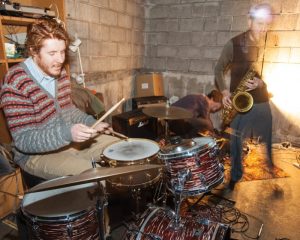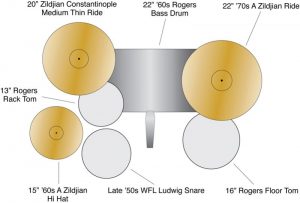Get Yer Kit Off: Joe McCallum
Get Yer Kit Off: Joe McCallum
Having previously kept time for alt-rock band Atlas, Joe McCallum is these days “living the dream”, playing live and in-session with local country artists like Tami Neilson, Delaney Davidson and Marlon Williams, tutoring and letting loose with jazz group The Harmolodic Bird. T54’s Matthew Scobie asked the questions so we could learn more about this in-demand Lyttelton-based drummer.
What kind of work have you been doing lately?
The last six months have been really fun. First, recording Tami Neilson‘s album at The Sitting Room in Lyttelton with Ben Edwards. Then I recorded Delaney’s new album, which is classic prolific Delaney, with Ollie Harmer at The Lab. I also had a really great time playing in the Christchurch Jazz Festival with the Harmolodic Bird. This was made up of Jeff Henderson on sax, Gerard Crewdson on trumpet and pocket trombone, Reuben Derrick on sax and Tom Callwood on double bass, playing the music of Ornette Coleman and Don Cherry. Being called up to play a solo set to open up for Peter Brotzmann was pretty special as well. So yeah… just living the dream really.
 So switching between free jazz and the pop/country thing. How have you found that transition back and forth?
So switching between free jazz and the pop/country thing. How have you found that transition back and forth?
Well those are two of my favourite worlds to be in. I don’t think of myself as a very good straight up rock drummer or covers drummer. There is a trade off between them though, so if I’m not playing free creative music, using those muscles and my ears in that way, then I’m definitely not prepared to play those sorts of gigs. The physicality of playing for a long period of time with that concentration, and being in the moment, requires practice.
How did you get into drums in the first place?
I’m a classic, cliché, upside-down pots and pans with the chopsticks guy from a very early age. There are photos of me playing to my sister. I remember seeing sparkly things in the back of a car and having my grandma explaining to me that was a drum kit. But it was when the St. Andrews pipe band came and did a demonstration at my primary school that it really started. I got to hold the snare and have a tap and my dad wanted me to connect with my Scottish roots. I was lucky to get into that sort of marching around the field thing really early. The mass bands where all the bands march together is almost like free jazz, it’s all beginners and seniors together and just a big wall of sound. Eventually I moved onto a drum set through high school and got in the jazz band.
How about tertiary music education?
After high school I went to the Christchurch Jazz School, to do a BMus, where I got to do music 24 hours a day. The best thing about that was just meeting all the people. The lessons were great with Ted Meager and Nick Gaffney. Going to see all the new music and being exposed to it. At the parties, the bars, and just hanging out, there was always a jazz CD on. It was like absorbing it rather than being a book-based theory sort of thing. Going to the Honey Pot café and seeing the original Oscillators play with Chris O’Connor and others.
I was lucky that Nick Gaffney and Chris were both living in Christchurch at the time. They were both posties, so you’d see them on their bikes delivering the mail, but they’d be out playing every week. After that I did honours in music at the University of Canterbury and it was there, through my tutor Elaine Dobson, that I got exposed to the Alan Lomax field recordings which is like a gold mine, and I was exposed to the ethno-musicology thing. After that I did a teaching diploma.
What did you learn from Chris O’Connor? He’s a pretty inspirational player.
He’s just got so much energy for music, endless creativity. He’s really good at having tricks to get rid of the head and anxiety stuff. It’s about being musical and rhythmic to get the most out of the music. He taught me a lot more than chops and rudiments, we went over that stuff, but he’s also big on musicality.
And how did you get involved with the Lyttelton country scene?
Well I lived in Lyttelton, that helped… and I knew Marlon. I remember walking in off the street at Goodbye Blue Monday and seeing Delaney [Davidson] and thinking, ’Phwoarh, what the hell is this? This is amazing.’ He just really struck me as someone I wanted to play with. Eventually I did a project with Ben Woolley on bass, and that just spread by word of mouth. It just kind of snowballed after that.
 So what about your day job, if you’ve got time for one?
So what about your day job, if you’ve got time for one?
I teach high school and primary school music part-time. I also take part of the After 3 Hagley jazz course. It’s a real privilege to be able to teach music. I had a student come up to me the other day whos building a drum kit with his dad, using a wheelbarrow and some paint cans.
I also teach over the internet to kids on the West Coast. There are some kids in Karamea who, for the bulk of the lesson we just go through the basics, but at the end we trade solos. They’ll do one and they do some great stuff that I wouldn’t think of. They use their ears and their instincts instead of their muscles and their brain. I guess you learn it then unlearn it – like Picasso. He mastered it when he was young and then broke it down for the rest of his life. He was not afraid to destroy his craft.
I’ve gone part time at work this year so I can focus more on my playing. Paul Motian said in an interview, “Just touch your instrument every day.” I work on technique but also musicality. At the moment I’m working on jazz stuff on the ride cymbal, the spangalang and the independence. Also material from Sydney drummer Simon Barker – his Korean rhythms – so I’m trying some of that stuff, groupings of 5s, 7s and relaxed strokes. Then I do a musical section to balance it out, like Chris told me.
For playing solo I use nursery rhyme rhythms, playing it plainly on the toms and then using the structure of that nursery rhyme to create a solo. Maybe I’ve given away the secret, but as Chris says, it’s like there’s something embedded in our subconscious with nursery rhymes. It’s a good place to start.
What’s the key for you to playing a song, rather than overplaying drums?
Listening really, active listening. Listen to the vocalist and their phrase if theyre going to a big section, you dont just do a fill over top of it but maybe instead say something complementary to what shes said. Youve got to listen to the other musicians but also listening to a lot of different records helps.
 I guess we better talk about gear then. What have you got going on?
I guess we better talk about gear then. What have you got going on?
Well for convenience I usually just use what is available around the place. I do have a soft spot for vintage gear. I’ve got a nice old early 60s Rogers, an early ’70s Yamaha with smaller sizes, and a 50s Ludwig.
As far as cymbals go, mostly old A Zildjians and a Constantinople ride, or a 22 Bosphorous ride too. Ive got about six rides and no crashes.
I’ve got 15 Avedis hi-hats as well. And I’ve also got my bag of bells and whistles, pot lids, shakers, tambourines. I like trying to find as many sounds out of the drums as I can get – sometimes the snare sound on its own just isn’t right.
Any other insights to share?
One cool thing in recording the Tami album was having the vocalist standing about two metres from my drum kit belting out perfect take after perfect take, and we’d have to like… choose the best drum take. I really enjoyed recording live and having us working together at the same time. Playing live with a strong vocalist is great.
